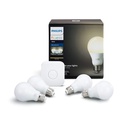Working from home is often a balancing act between managing a workload and making sure the children haven’t set aflame anything in the living room. Unfortunately, spending more time at home can also sometimes lead to an unexpected increase in your energy bill. Maybe one of your kiddos is insistent upon readjusting the thermostat, or perhaps you’re guilty of forgetting to turn off the television after sipping your morning coffee. Whatever the case may be, we’ve got 5 energy saving tips you can use to save money and live more energy efficiently.
Ditch Your Incandescent Light Bulbs
Yes, it’s 2020 and therefore time to toss out your incandescent light bulbs. At least this is the case if you’re looking to reduce your family’s energy consumption.
Ditching incandescent light bulbs is on our list of energy saving tips because they can’t hold a candle to LED bulbs. Why, might you ask? Because LED bulbs use 75% less energy and last up to 25 times longer than incandescent lighting. And who wants to work under the lackluster glow of an incandescent bulb when they’re trying to finish a big assignment? Staying focused is much easier with an LED bulb’s sharp stream of light.
Another benefit to using LED bulbs is that they aren’t nearly as expensive as they once were. While in the past many families might have seen them as the beneficial but unobtainable option, a decrease in price tag makes them more suitable for any family’s budget. They even are starting to come in the Edison bulb format which everyone loves.
Though with each bulb lasting years, it also might be a good idea to check out smart bulbs like the Philips Hue lights to add to your smart home technology. These lights can be adjusted from your smart phone, have very specific timers (like sunset or sun-up), change colors, and integrate with voice assistants like Alexa.
Unplug What You’re Not Using
More and more Americans are spending time at home, but that doesn’t mean we’re using more appliances.
So take inventory of what devices you’re not regularly using and unplug them. For even more efficiency, unplug a device whenever you’re finished using it. This reduces the odds of you forgetting to do so down the line. From toaster ovens and coffee makers to laptop computers and phone chargers, they should each be unplugged from their respectable power source after use.
We also recommend using a smart power strip at your desk for any work-related devices. That way, at the end of your workday, your power strip will switch the power off after noticing a device is on standby or hasn’t been in use for a while.
Use The Energy Saving Settings On Your Gadgets
The most resourceful energy saving tips don’t have to be in the form of extravagant measures.
Reducing energy as you work from home can be as simple as utilizing the built-in energy-saving settings on a device you’re likely using right now—a laptop. This limits the number of times you have to resort to charging the device from a wall outlet.
Devices, like Apple’s MacBook Pro, make it easy to scale back on energy usage by giving users the freedom to dim the screen’s display, put your computer to sleep when you’re not using it, or disconnecting from Wi-Fi and Bluetooth.
If you’re looking for a new laptop to use while working from home, choose one that meets Energy Star’s guidelines and can help cut back on yearly expenses.
Use Smart Technology
Smart home technology is known for swapping out our daily stresses with comfortable and stress-free living. This is especially useful while we’re working from home and juggling conference calls and projects with childcare and homeschooling.
One of our favorite smart devices that can help cut back on energy usage is a smart thermostat like the Nest Thermostat.
With a smart thermostat, you never have to worry about the pesky interruptions that come from getting up to readjust the temperature in the middle of your work. Instead, use the device to control and manage when you want the air to adjust as well as the duration for the change.
Another great thing about smart thermostats is that they take note of the activity happening around your home to adjust accordingly to bring comfort and savings. This includes switching off when you’ve stepped outside to the back patio for a Zoom meeting or to eat your meal during a lunch break.
For hands-free control, integrate your smart thermostat with a smart speaker to enjoy quicker adjustments from the comforts of wherever you may be sitting.
Invest in Solar Energy
On average, a homeowner can expect to pay $1,300 a year just on their electricity.
A clear and effective way you can save money and energy throughout your home is with solar energy. This growing trend is rising in popularity in part because it reduces the costly expense that stems from using electricity. Others are in favor of solar energy because it reduces their carbon footprint by up to 80% per year and provides their loved ones with clean energy.
A simple measure you can take to enjoy the many benefits of solar energy is by installing solar panels on your home. This generates a flow of continuous residential solar energy as you work from home, powering your home’s appliances while using green energy. Certain solar panel systems even give you the freedom to monitor your home’s energy use and solar production. Other systems have solar batteries that make it easy to power your home at night.
Oh, and because it’s free to capture energy from the sun, you can continue to enjoy saving money and energy from your solar-powered home for many years to come.








